In SAP S4/HANA, a scheduling agreement is an outline purchase agreement where the buyer and the supplier agree to send a particular material at a specific time, place, and quantity. Scheduling agreements are usually long-term, and they output an agreement that specifies a vendor and a good being purchased at a regular interval with a specific period.
Another type of outline agreement is contracts, where the purchase orders are considered release orders against the agreement written between the buyer and the supplier.
This article will provide a detailed overview of Scheduling Agreements and differentiate between essential concepts that consultants and SAP users often misunderstand regarding scheduling agreements. Finally, we will go through a complete scheduling agreement scenario of SA’s in SAP S4/HANA.
Table of Contents
Why do we need Scheduling Agreements in SAP?
Purchasing scheduling agreements are beneficial in repetitive industries, such as automotive, electronics, and manufacturing, where demand planning is not volatile. For example, the automotive sectors can’t afford to hold inventory and therefore requires just-in-time functionality, and scheduling agreements fulfils this need. Usually, when we have scheduling agreements in place, that also means that there is a close working relationship between the buyer and the supplier.
What is the difference between a PO and a Scheduling Agreement?
The purchase order itself is a an example of a scheduling agreement; we have the supplier, the item, and the contract to supply that material over a particular period. However, the agreement we have in the purchase order does not have a validity period; it has delivery dates.
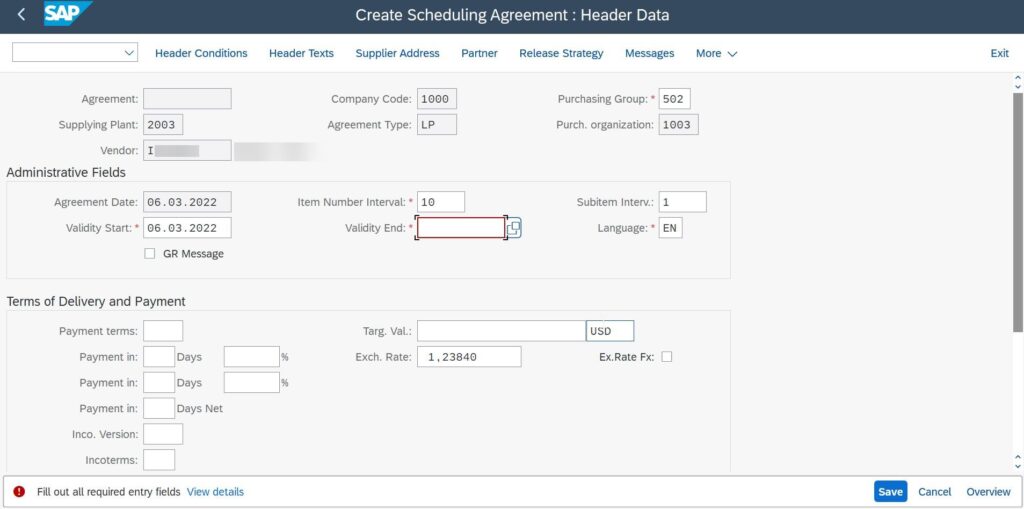
The moment you receive your materials against either your PO or your scheduling agreements, SAP treats them both the same. Upon saving your GR, SAP produces one material document and one account document. SA’s are concrete purchasing documents, and they contain all the necessary information to make a purchase.
The difference is related to time frames and your emphasis on the time needed to deliver your material. The PO is generally a one-time deal, whereas the scheduling agreement is long-term. Finally, POs GRs have to be paid at total prices upon GR generation, but in the case of all of the outline agreements, the payment is done periodically and is not based on the GR. Therefore, the account assignment in SA’s is not mandatory.
What is the difference between a contract and a Scheduling Agreement?
The main difference is that in a contract in SAP, you must create a release against that contract in the form of a purchase order to receive your goods. On the other hand, you can directly receive against these scheduling lines after a scheduling agreement is released.
Remember, both contracts and scheduling agreements are examples of outline agreements.
Benefits of Scheduling Agreements
In SAP S4/HANA, Schedulig Agreements have a lot of advantages to consider over standard Purchase Orders, and they are the following:
- Scheduling agreements reduce purchase time by reducing the number of POs that needs to be created and managed.
- Allows a paper-less procurement.
- Designed for JIT – Or just in time manufacturing.
- Promotes strategic partnership with the supplier.
- Promote Supply chain Visibility.
- Integrates with SAP Ariba.
- Integrates with SAP TM.
- System can automatically create scheduling agreements from SAP PP or APO components.
SAP S4/HANA Scheduling Agreements – Deep Dive
Create Scheduling Agreements using ME31L
In SAP, scheduling agreements can be created manually or can reference the following documents:
- Purchase Requisitions
- Quotations
- Contracts
- Any other scheduling agreement.
- Scheduling Agreement Stock Transport Order between your plants.
If you want to reference any of the above, you can choose what you want to reference:

To create a scheduling agreement, you must have the following mandatory fields nearby:
- Account assignment category
- Purchasing Organization
- Purchasing Group
- Account assignment data.
If you do not wish to refer to these documents to create your SA, you can also create a manual Scheduling agreement by the following path:
Logistics – Materials Management – Purchasing – Outline Agreement – scheduling Agreement – Create – Vendor Known.
Note: You can also use the tcode: ME31L


Step 1:
Enter the vendor, p.org, p.group, and plant in the first screen. In here, you also need the agreement type:
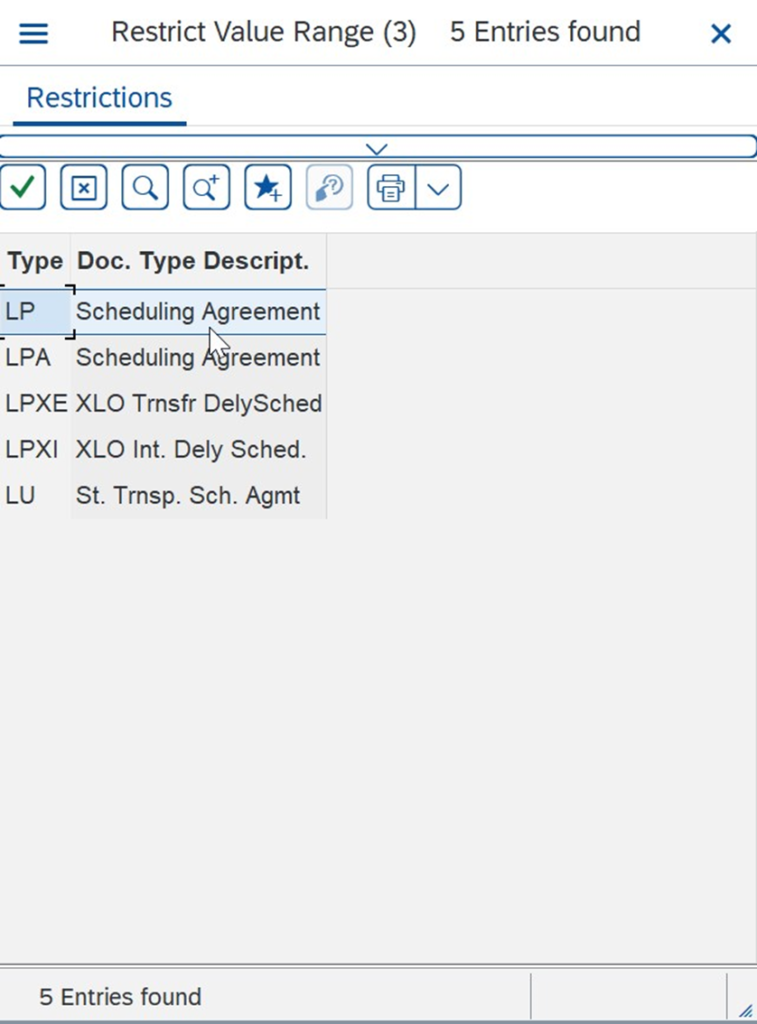
LPA (with release documentation)
LP (without release documentation)
LU (Stock transport scheduling agreement)
Once you fill up all the necessary details, press Enter.
Step 2
You have now entered the header screen, and this looks very similar to contracts in SAP if you have ever worked with them:

The most important field to fill here is the Validity Date. You can also specify the target SA value and the payment terms in this field. Once you finish, hit Enter.
Step 3
You are now in the Item Overview screen, and it looks like this:

This is where you enter all the item level information in your SA; here, you need the following information:
- Material number.
- Target Quantity.
- Price.
- OUn or Order Unit.
- OPU or Order Price Unit.
- Plant.
- Account Assignment.
- Conditions (if required).
- Material short text if you enter a non-stock or a service.
- Storage location.
- Material Group (if service).
If you have set up an output control in SPRO for your Scheduling Agreements, once you save here, a message (that looks like contracts or POs) will be transmitted to your vendor.
Upon Saving, you will receive a message similar to this at the left bottom of your screen:

Once saved, you can go back to your Scheduling Agreements by going to the following path:
Change Scheduling Agreement – ME32L
Logistics – Materials Management – Purchasing – Outline Agreement – scheduling Agreement – Change
Note: You can also use the tcode: ME32L

Step 4:
Type the Agreement number we saved from above, and hit Enter or Overview:

Here, double click your material again or go to Item – Details.
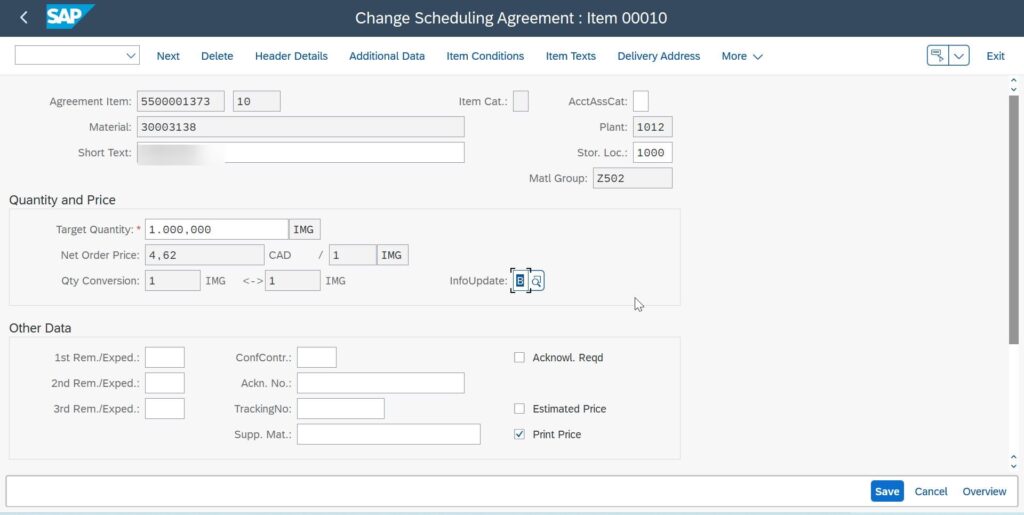
You can enter Item conditions regarding pricing, surcharge, discount, and other data related to reminders and the info update indicator. Do not forget to click on Save once you finish.
Create Schedule Lines – ME38
So, you finished setting up your SA by following the steps above, so what is next? Let us manually maintain the delivery schedule for our material. FYI, scheduling lines mean exactly the same in SAP, your delivery schedule.
You can go to the following path:
Logistics – Materials Management – Purchasing – Outline Agreement – Scheduling Agreement – Delivery Schedule – Maintain
Note: You can also use the tcode: ME38

Step 1:
Enter the agreement number:

Step 2:
Highlight the item, and Go to Delivery Schedule:

Step 3:
Maintain your item’s delivery schedule. Here, you specify the scheduled quantity, time, delivery date, and the statistics-relevant delivery date.
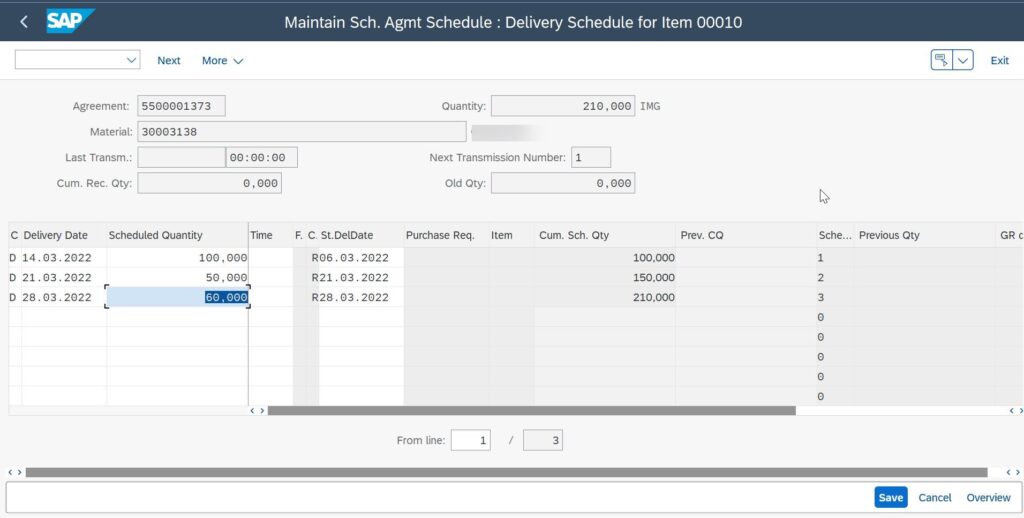
The statistical-relevant delivery date is used for supplier evaluation, and it is used to determine how your supplier’s adherence to the stipulated delivery dates in the agreement. If the supplier keeps delivering later than the delivery date, their score worsens if you have enabled supplier performance in SAP S4/HANA or Ariba.
Below is how SAP defines Statistics-Relevant Delivery Date:

Goods Receipt for Scheduling Lines
Once you have saved your scheduling lines with ME38, you can receive the goods based on the delivery dates we kept when we created our scheduling agreement. Receiving scheduling lines is virtually the same process as receiving against the PO.
Step 1:
Go to transaction code MIGO:

We are using the same process by going to: Goods Reciept – Purchase Order – Input here your SA number instead of PO.
Step 2
Goods Receipt – Purchase Order – Here, enter your Scheduling Agreement Number. We are also going to use the same movement type: 101.

You can Check your MIGO here and Post.
Scheduling Lines Tables:
In SAP, scheduling agreements are typically stored in tables that are specific to the procurement module. Some of the main tables that are used for scheduling agreements include:
EKET: This table contains the delivery schedules for scheduling agreements. It includes information such as the delivery dates, quantities, and confirmation status.
EKEK: This table contains the header information for scheduling agreements, such as the agreement number, supplier, and agreement type.
EKKN: This table contains the account assignment information for scheduling agreements. It includes details such as the cost center, order, or project that the procurement is assigned to.
EKPO: This table contains the item details for scheduling agreements, such as the material number, quantity, and pricing.
EKKO: This table contains the header information for all purchasing documents, including scheduling agreements. It includes information such as the document number, supplier, and purchasing organization.

If you want to see a table of all SAP MM relevant tables, click here
Scheduling Lines Reports in SAP
There are many ways you can view scheduling lines reports in the standard SAP settings:
Transaction code ME2W ME2L or ME3L if depending if you want to see the report by supplier, document or issuing supplier:
Step 1: Go to tcode ME2W or any of the reports mentioned above
Step 2: Change scope of list to ALV or ALLES_ALV
Step 3: Change document type to LP or LPA
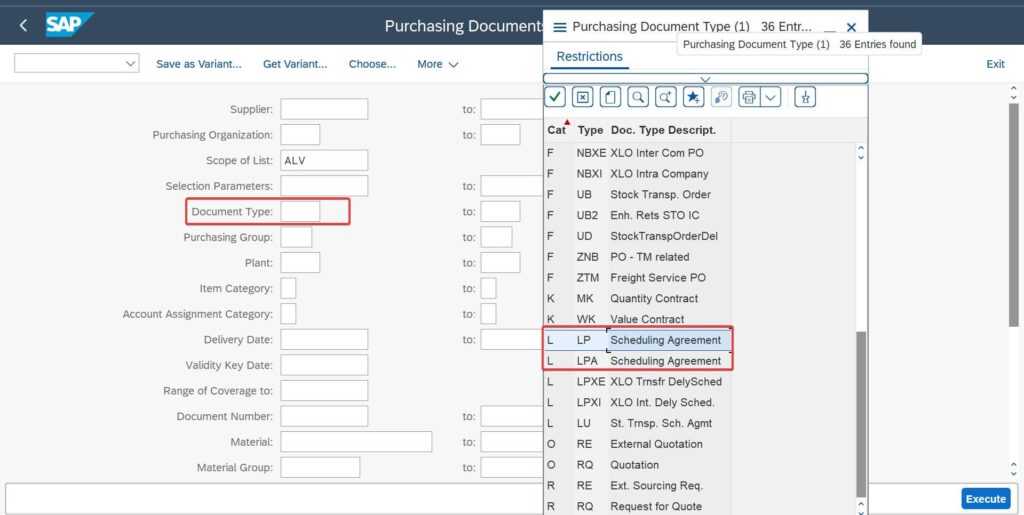
Step 4: Go to Views and change Purchasing Document to Delivery Schedule
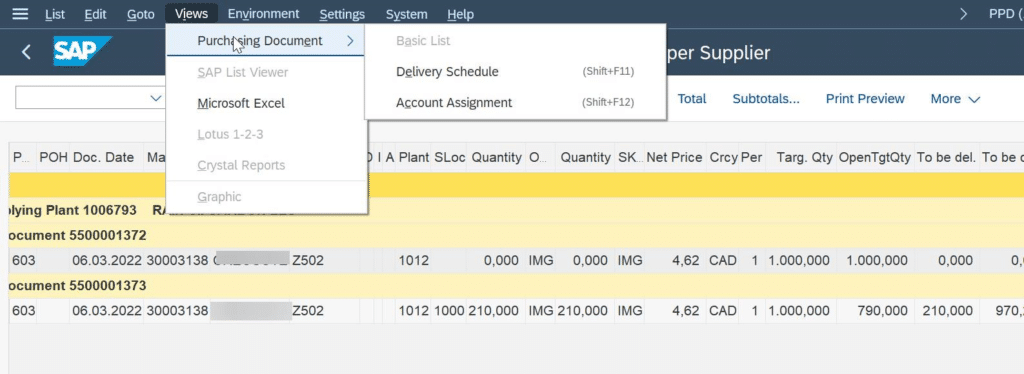
If you want more, you can build your own report by using a combination of the above tables.
Conclusion
Scheduling agreements provide an essential scenario for industries running repetitive manufacturing that require JIT delivery. The main benefit of scheduling agreements is that you can plan well in advance the materials or components that you need to operate your business. The main drawback of scheduling agreement is its inability to be centrally used by all your plants for example. However, you can always reference a centrally created contract in SAP and cater delivery schedules by creating a specific scheduling agreements for your specific plant.
- Overview of the Material Master in SAP S/4HANA - January 2, 2024
- SAP FICO TRANSACTION CODES (MOST COMMON) - December 24, 2023
- Best SAP S/4HANA MM Books for Beginners and Advanced Learners - November 25, 2023





0 Comments